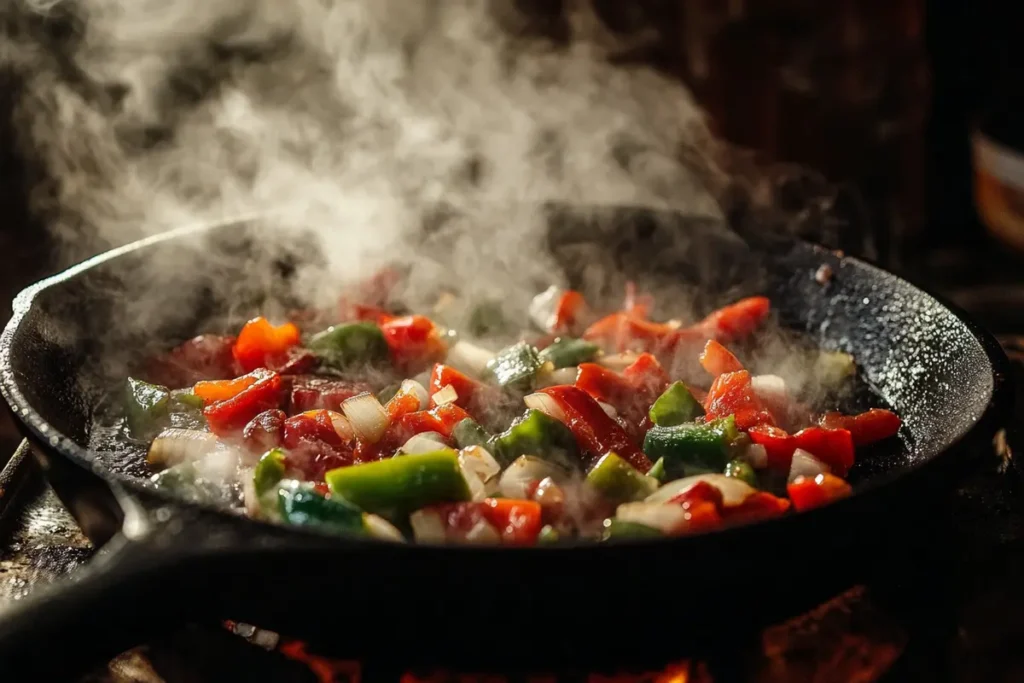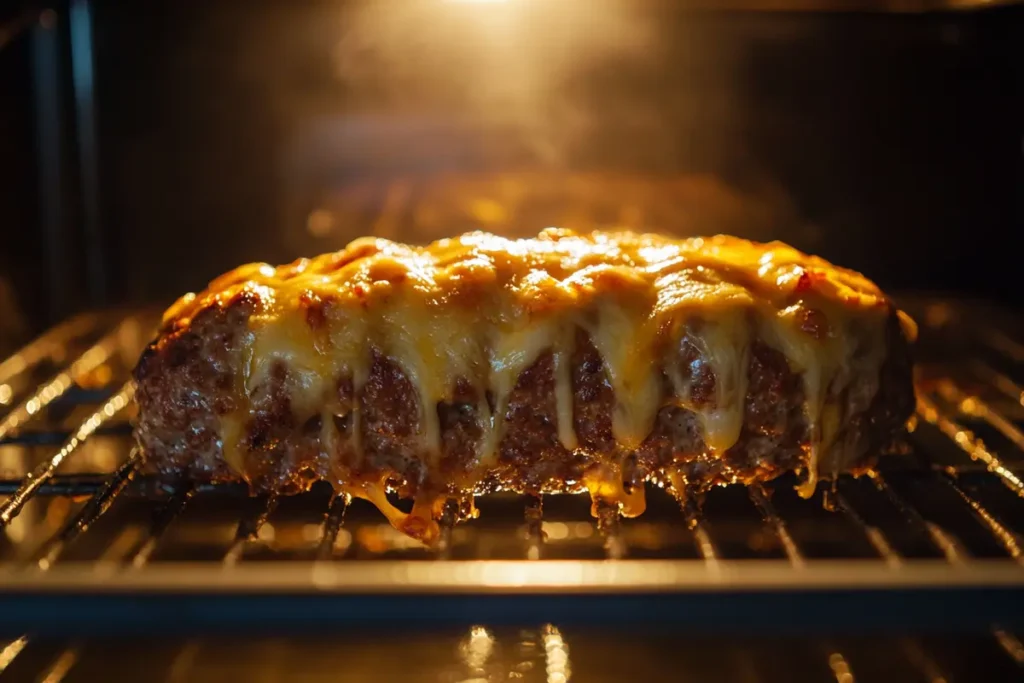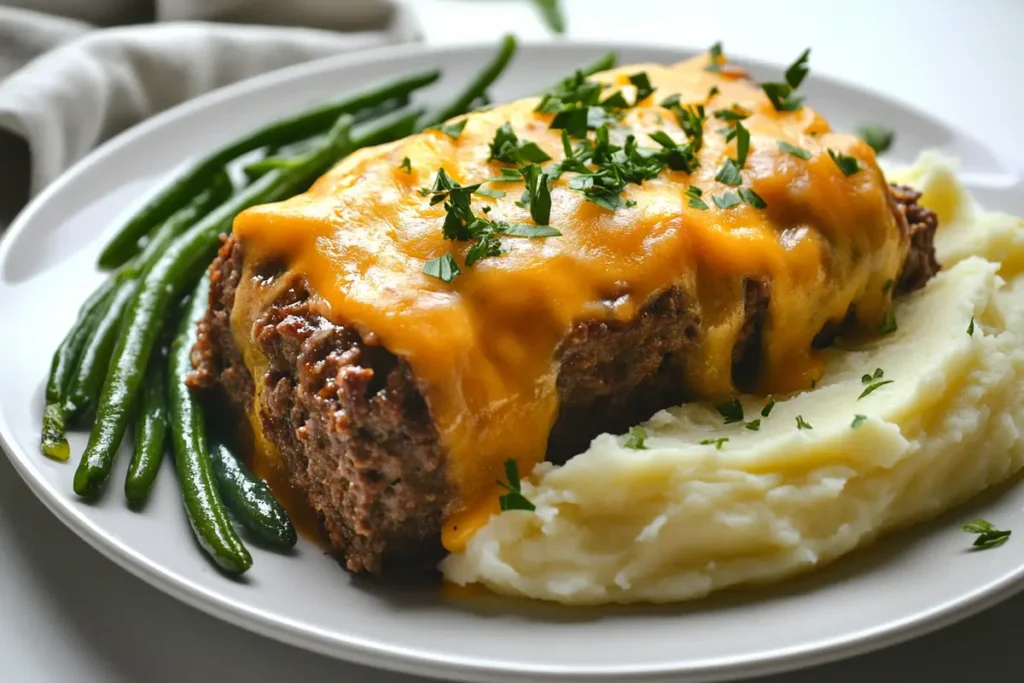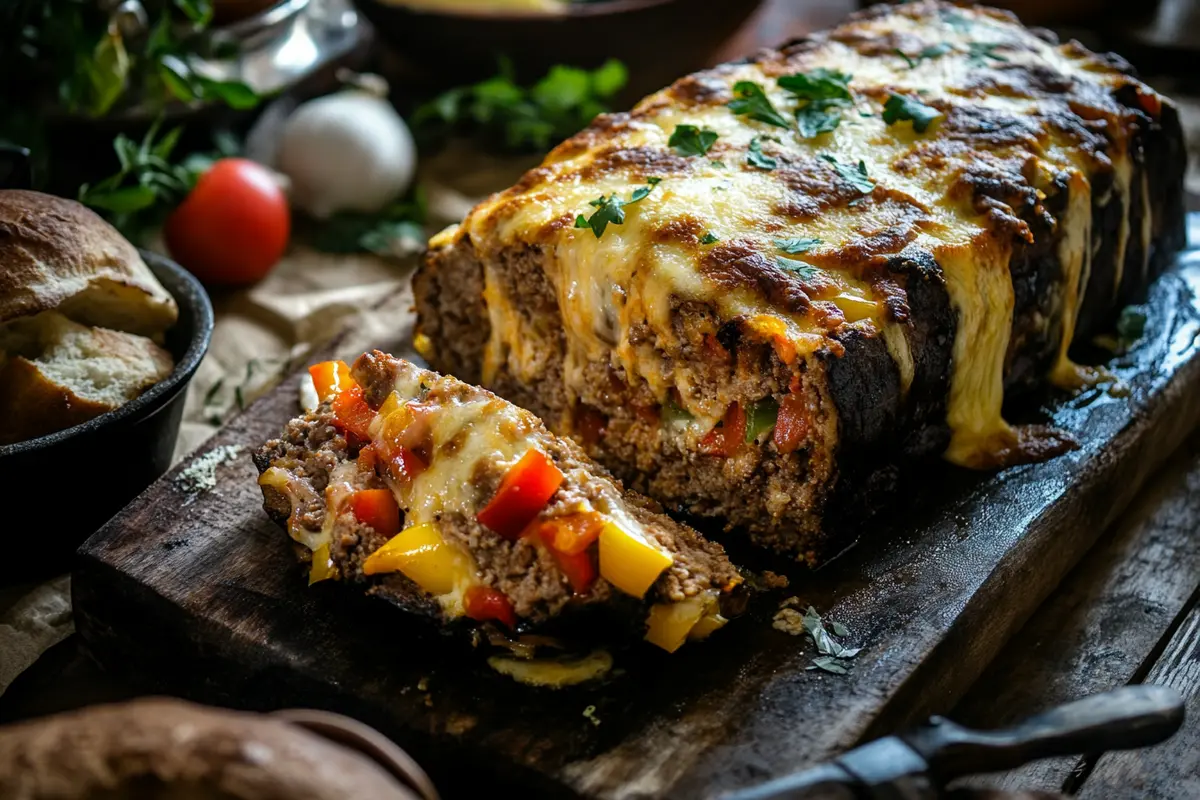Introduction
When it comes to hearty, comforting dinners, few dishes evoke such pure satisfaction as philly cheesesteak meatloaf. This savory masterpiece blends the rich flavors of a classic Philly cheesesteak sandwich with the timeless appeal of homemade meatloaf. The result is a tender, cheesy, and intensely flavorful dish that easily becomes the star of any dinner table.
Why Philly Cheesesteak Meatloaf Is Special
This dish captures the essence of two comfort foods. Meatloaf has always meant warmth, familiarity, and home. Meanwhile, a Philly cheesesteak conjures images of bustling city streets and bold flavors. Combining them creates a robust taste profile that satisfies like few others can. Moreover, this fusion adapts to many palates. For example, you can add extra veggies or tweak seasonings to match your family’s preferences.
Key Ingredients for Philly Cheesesteak Meatloaf
When creating your philly cheesesteak meatloaf, it pays to start with quality ingredients. Each component plays a vital role in achieving that signature taste and texture.
Ground Beef:
Use lean or medium ground beef for a balanced result. However, avoid too lean because fat adds moisture.
Bell Peppers and Onions:
These vegetables bring sweetness and aroma. In addition, they add essential texture. Dice them small for even distribution.
Provolone Cheese:
Provolone offers a mild, buttery flavor. It melts beautifully and creates a luscious, cheesy core within your loaf.
Breadcrumbs:
Breadcrumbs help bind the loaf. However, do not overuse them. Just enough provides structure without drying it out.
Eggs:
Eggs help hold the mixture together. They create a cohesive mixture and ensure the loaf slices cleanly.
Seasonings:
Salt, pepper, garlic powder, and Worcestershire sauce add depth. In addition, consider paprika for subtle warmth.
Choosing the Right Meat
The main star of philly cheesesteak meatloaf is the beef. Therefore, selecting the right grind matters. For example, an 85/15 lean-to-fat ratio delivers tenderness and flavor. Ground chuck is often ideal because it balances juiciness and richness. On the other hand, a very lean mixture might turn out too dry. So, stick to well-marbled ground beef for a moist and succulent result.
In contrast to a standard meatloaf, where you might use a mixture of beef, pork, or veal, here the classic Philly inspiration leans toward beef only. Moreover, you want that robust, full-bodied flavor that recalls the original cheesesteak. By ensuring a good quality ground beef, you lay a solid foundation for your final dish.
Prepping the Vegetables
The signature flavor of philly cheesesteak meatloaf relies heavily on the vegetables. Bell peppers and onions are at the heart of any Philly-style dish. However, how you prepare them can affect the final result.
Tips for Cutting Vegetables:
- Dice peppers and onions into small, uniform pieces.
- Sauté them until tender before mixing.
- Season them lightly with salt and pepper.
By sautéing the peppers and onions, you release their natural sweetness. Therefore, the loaf gains more complex flavor. Additionally, pre-cooking these veggies helps ensure the loaf doesn’t become watery. The result is a better texture and consistent taste.

The Role of Cheese
No philly cheesesteak meatloaf would be complete without gooey cheese. Provolone is a top choice, but don’t feel limited. For example, mild Cheddar or Monterey Jack also work well. However, provolone’s mellow flavor and creamy texture give an authentic cheesesteak vibe.
Assembling the Mixture
Once your veggies are prepped and your ingredients measured, it’s time to assemble the mixture. Working gently and efficiently helps maintain a tender texture. Overmixing can make it dense. Therefore, be sure to combine the ingredients just until they hold together.
Basic Steps:
- In a large bowl, combine ground beef, sautéed peppers and onions, breadcrumbs, and beaten eggs.
- Add seasonings like garlic powder, salt, pepper, and Worcestershire sauce.
- Mix gently until combined.
- Shape into a loaf and press cheese slices into the center, covering them completely with the meat mixture.
In addition, ensure even distribution of ingredients. For example, fold the mixture with your hands or use a fork. The goal is to integrate everything without packing it too tightly. Above all, a light hand results in a moist, tender finished product.
Baking Your Philly Cheesesteak Meatloaf
After shaping your loaf, it’s time to bake. Preheat the oven to about 350°F. Place the loaf on a lined baking sheet or in a loaf pan. However, ensure there’s room around the loaf for even heat circulation.
Baking Tips:
- Bake until the internal temperature reaches 160°F.
- Consider using a meat thermometer for accuracy.
- Avoid overbaking, as this dries out the loaf.
In addition, halfway through baking, you might want to tent the loaf with foil if it starts browning too quickly. This preserves moisture. Therefore, you end up with a juicy, flavorful result. Finally, let it rest for about 10 minutes after baking. This resting time helps the juices redistribute, making slicing cleaner and tastier.

Serving Suggestions and Pairings
When serving philly cheesesteak meatloaf, think about side dishes that complement its hearty, savory flavor. For example, fluffy mashed potatoes or creamy polenta absorb the juices and balance the richness. In addition, roasted vegetables like broccoli or carrots add color and nutrients.
Alternatively, consider serving it with a side salad for freshness. A crisp green salad with a light vinaigrette cuts through the richness and cleanses the palate. Furthermore, if you want to lean into the Philly theme, serve slices on crusty rolls. Top with extra cheese and sautéed onions for a sandwich-style presentation.

Storage and Reheating
Leftovers are a blessing because philly cheesesteak meatloaf reheats beautifully. Store leftovers in an airtight container in the refrigerator for up to three days. Therefore, you can enjoy quick lunches or easy dinners later in the week.
To reheat, slice only what you need and warm it gently in a microwave or oven. For example, place slices in a covered dish with a splash of broth to maintain moisture. In addition, consider adding extra cheese on top before reheating for a fresh, melty finish.
Variations and Ingredient Swaps
While the classic approach works best, you can tweak this recipe. For example, try blending ground beef with a bit of ground turkey or chicken for a lighter version. However, ensure you maintain enough fat content for flavor.
Additionally, experiment with different cheeses. Sharp Cheddar brings a tangy edge, while smoked provolone adds complexity. Moreover, you can add mushrooms for an earthy dimension. The key is to preserve the Philly cheesesteak essence—savory beef, sweet peppers, onions, and a cheese that melts like a dream.
Making It Healthier
If you want a healthier spin on philly cheesesteak meatloaf, small changes help. For example, use leaner meat, but add a touch of olive oil for moisture. Additionally, whole-wheat breadcrumbs add fiber without sacrificing texture.
In addition, load up on vegetables. Finely chopped spinach, mushrooms, or even shredded zucchini can hide inside your loaf, boosting nutrients. Above all, balance is key. Keep the signature taste intact while making subtle improvements that fit your lifestyle.
Perfecting the Texture
Texture can make or break a meatloaf. Therefore, pay attention to details. Under-mixing leaves dry patches, while over-mixing creates a dense loaf. In contrast, a gentle hand yields a tender texture.
Moreover, the right ratio of breadcrumbs matters. Too many breadcrumbs lead to a gummy mixture, while too few result in a crumbly loaf. Experiment to find your sweet spot. Above all, taste and adjust seasonings as you go. A well-seasoned mixture ensures you’ll love the final product.
The Importance of Resting Time
When you remove your philly cheesesteak meatloaf from the oven, it’s tempting to slice immediately. However, resting time improves the final result. In addition, letting the loaf rest allows the juices to settle, which enhances tenderness.
If you slice too soon, juices escape, making the meatloaf drier. A 10-minute rest on a cutting board under a loose foil tent works best. Consequently, every slice will be flavorful and moist, capturing the essence of a Philly cheesesteak in every bite.
Common Mistakes to Avoid
Even seasoned cooks encounter pitfalls. Therefore, learn from these common mistakes:
- Overmixing: Work gently and stop when combined.
- Using Extra-Lean Beef: A bit of fat ensures moisture and flavor.
- Skipping Pre-Cooked Veggies: Raw peppers and onions release water, making the loaf soggy.
- Ignoring Temperature: Use a meat thermometer for accuracy.
- Not Resting the Loaf: Patience improves juiciness and texture.
Addressing these issues ensures your philly cheesesteak meatloaf meets every expectation. Above all, remember that practice improves your technique over time.
Serving a Crowd
If you’re hosting a gathering, philly cheesesteak meatloaf makes an impressive centerpiece. It scales easily. For example, double the recipe and form two loaves. Bake them side-by-side, adjusting cooking times as needed.
In addition, offer a toppings bar. Provide sautéed mushrooms, additional cheese, or pickled peppers so guests can customize their slices. Moreover, consider pairing it with a simple pasta salad or roasted potato wedges. This encourages guests to linger and savor the meal.
Making Ahead and Freezing
Life gets busy, so planning ahead matters. You can prepare the loaf mixture in advance and store it in the refrigerator for up to a day before baking. Therefore, when mealtime arrives, you just pop it in the oven.
Additionally, this dish freezes well. Wrap it tightly in plastic wrap, then in foil, and freeze for up to three months. In contrast, if you prefer freshly baked, shape and freeze the raw loaf. When ready to cook, thaw overnight in the refrigerator and bake as directed. This strategy ensures delicious home-cooked meals are always within reach.
Pairing with Beverages
Pairing beverages with philly cheesesteak meatloaf is part of the fun. A light red wine like a Pinot Noir complements the savory flavors. For example, a cold craft beer also works well, balancing richness with refreshing notes.
On the other hand, if you prefer non-alcoholic beverages, try iced tea or sparkling water with a hint of lemon. In addition, consider a bold root beer for a nostalgic, satisfying pairing. Above all, choose a drink you enjoy, enhancing the entire culinary experience.
Nutritional Considerations
While philly cheesesteak meatloaf is a comfort food, you can enjoy it as part of a balanced diet. For example, serve smaller portions alongside nutrient-rich sides like roasted vegetables or a green salad.
In addition, consider using reduced-fat cheese or leaner cuts of meat if you watch your calorie intake. This dish can adapt to various dietary needs without losing its essence. Above all, moderation and variety remain key to a healthy lifestyle.
Presentation Tips
Visually appealing dishes often taste better. Therefore, present your philly cheesesteak meatloaf with care. Slice it neatly and arrange the pieces on a platter. In addition, garnish with fresh parsley or chives for a pop of color.
Moreover, serve condiments on the side. Offer homemade gravy, a tangy sauce, or a spicy aioli for dipping. These extras add fun and personalization. Above all, let your personal style shine through in the final presentation.
Sustainability and Ingredient Sourcing
Choosing responsibly sourced ingredients contributes to better flavor and supports local producers. For example, consider purchasing high-quality, sustainably raised beef. In addition, buying local produce ensures freshness and reduces environmental impact.
Furthermore, using quality cheese from reputable dairies ensures that you support artisans who take pride in their craft. Above all, this approach reflects a mindful cooking style that respects the ingredients and the communities that produce them.
Enhancing Flavor with Herbs and Spices
Though this dish is straightforward, you can enhance its flavor. For example, add fresh thyme or oregano to the meat mixture. In addition, a touch of smoked paprika elevates the savory depth, evoking the grill-like flavor of a cheesesteak stand.
Moreover, consider a pinch of red pepper flakes for subtle heat. However, don’t overpower the main flavors. A light touch ensures balance. Above all, each ingredient should support, not overshadow, the philly cheesesteak meatloaf identity.
Experimenting with Sauces
A great sauce can take your philly cheesesteak meatloaf to new heights. For example, a mushroom gravy complements the earthy notes of the beef. In addition, a simple cheese sauce drizzled on top doubles the cheesesteak-inspired vibe.
Alternatively, try a roasted garlic aioli for a creamy, slightly tangy element. However, be mindful that sauces should enhance, not dominate. Above all, the loaf’s flavor remains the star attraction.
Frequently Asked Questions
What is the secret ingredient in Philly cheesesteak?
The secret ingredient is often the cheese. Traditionally, provolone or even Cheez Whiz creates that iconic creamy finish. However, quality beef and sautéed onions and peppers also matter.
What cut of meat is good for Philly cheesesteak?
For authentic Philly cheesesteak, thinly sliced ribeye is common. It’s tender, juicy, and flavorful. In contrast, sirloin or top round also work but may need more careful preparation.
What ingredient keeps meatloaf from falling apart?
Eggs and breadcrumbs usually keep meatloaf from crumbling. These binding agents help hold the mixture together and ensure clean slices.

